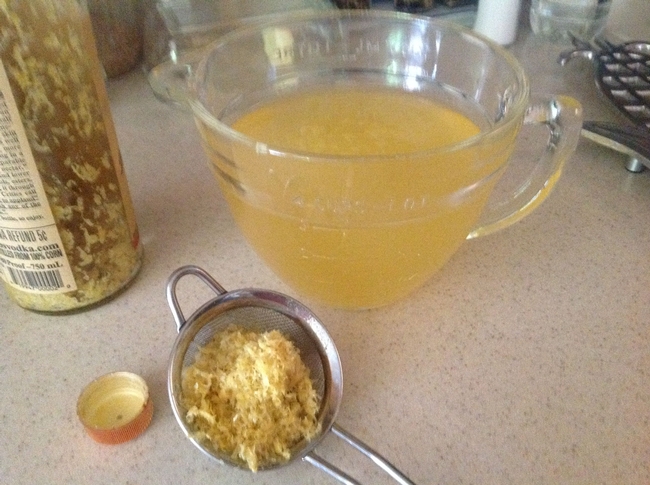About that lemoncello
One of the hazards of contributing to a shared blog, is that one forgets to post. So in this case, while I said in my last post that we would re-visit the lemoncello in mid-May, here it is September. Time flies.
The lemoncello is a huge success, we've been enjoying it on the hot summer afternoons that are plentiful in Davis. And here's how I got from pith to pleasure . . . .
The first steps in the lemoncello process were documented in this early Spring post. The recipe calls for 6 weeks of steeping the lemon zest in the alcohol in a cool, dark place; preferably, in a place where it won't be disturbed. I had placed mine in a place so cool, dark, and undisturbed it took me 45 minutes to find it.
But that resolved, I moved to the next step - filtering.
You can see that the zest from all of those lemons has settled to the bottom of the bottle. Lemoncello aficionados recommend a 2-step filtering process. The first step is to get most of the zest out using a fine sieve.
Look at all of this zest!
Quite a bit of solid material is left in the liquid after this process.
To remove these last solids, the liquid is filtered through a paper coffee filter. (Lemoncello purists, like coffee purists, would object to the use of a paper filter, saying it imparts a paper flavor.)
The next step is to add the cooled simple syrup. The basic simple syrup recipe calls for equal parts of sugar and water, but for lemoncello less sugar is used. For one 750ml bottle of base alcohol, you need 2-1/2 cups of water and 1-3/4 cups sugar. Add the sugar to the water in a medium saucepan and heat over medium heat. Bring to a gentle boil, stirring constantly, until the sugar is dissolved. Let the mixture cool completely to room temperature before adding to the lemoncello base.
Decant the mixture, and put in a cool, dark place for another 45 days. The addition of the simple syrup increases the volume, so you can't fit your mixture into the original bottle.
This mixture was moved into two tall glass bottles and set aside until early July.
You can put the finished lemoncello in the freezer or in the refrigerator. Enjoy it alone or in a cocktail on a hot summer afternoon when you need a little something refreshing!
If you want to make your own lemoncello, an excellent resource is the blog LemoncelloQuest.







Posted by jennifer wood on September 10, 2014 at 9:04 AM